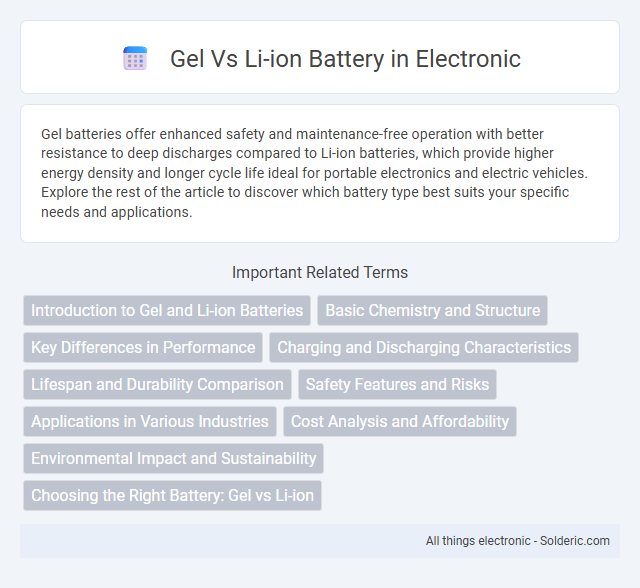Gel batteries offer enhanced safety and maintenance-free operation with better resistance to deep discharges compared to Li-ion batteries, which provide higher energy density and longer cycle life ideal for portable electronics and electric vehicles. Explore the rest of the article to discover which battery type best suits your specific needs and applications.
Comparison Table
| Feature | Gel Battery | Li-ion Battery |
|---|---|---|
| Electrolyte Type | Silica gel-based | Lithium-ion electrolyte |
| Energy Density | Low to moderate (30-50 Wh/kg) | High (150-250 Wh/kg) |
| Cycle Life | 500-1000 cycles | 1000-3000 cycles |
| Weight | Heavy | Lightweight |
| Maintenance | Maintenance-free | Maintenance-free |
| Temperature Performance | Good in extreme temperatures | Sensitive to high temperatures |
| Cost | Lower initial cost | Higher initial cost |
| Applications | Solar systems, wheelchairs, backup systems | Electronics, electric vehicles, portable devices |
| Charge Time | Longer | Faster |
Introduction to Gel and Li-ion Batteries
Gel batteries utilize a silica-based gel electrolyte to enhance safety, reduce leakage, and provide stable performance under various conditions. Li-ion batteries rely on lithium-ion movement between the anode and cathode, delivering high energy density, faster charging, and longer cycle life. Both battery types serve diverse applications, with gel batteries favored for deep cycle use and Li-ion batteries dominating portable electronics and electric vehicles.
Basic Chemistry and Structure
Gel batteries use a silica-based gel electrolyte that immobilizes the acid, preventing spillage and enhancing safety, while lithium-ion batteries utilize a liquid or polymer electrolyte that facilitates the movement of lithium ions between the anode and cathode during charge and discharge cycles. Gel batteries typically feature lead dioxide plates submerged in the gel electrolyte, offering durability and resistance to vibration, whereas lithium-ion batteries consist of layered materials such as graphite anodes and lithium metal oxide cathodes, enabling higher energy density and lighter weight. The structural difference results in gel batteries being preferred for deep-cycle applications with moderate energy needs, while lithium-ion batteries excel in high-performance, lightweight, and compact energy storage solutions.
Key Differences in Performance
Gel batteries offer superior deep cycle performance and enhanced resistance to sulfation compared to Li-ion batteries, making them ideal for applications requiring prolonged discharge. Li-ion batteries provide higher energy density and faster recharge rates, allowing for lightweight designs and rapid power delivery in portable electronics and electric vehicles. Temperature tolerance also differs; Gel batteries perform reliably in extreme cold, whereas Li-ion batteries require careful thermal management to maintain safety and efficiency.
Charging and Discharging Characteristics
Li-ion batteries offer higher charging efficiency and faster discharge rates compared to Gel batteries, making them ideal for applications requiring quick energy delivery and frequent cycling. Gel batteries excel in deep discharge tolerance and provide a more stable voltage output under load, which enhances longevity and reliability in steady, low-discharge scenarios. Your choice between these batteries should consider whether rapid charge/discharge or sustained, consistent performance is more critical for your device or system.
Lifespan and Durability Comparison
Gel batteries typically offer longer cycle life and better durability under deep discharge conditions compared to Lithium-ion batteries, making them suitable for heavy-duty applications. Lithium-ion batteries, while having a shorter overall lifespan, provide higher energy density and faster charging but may degrade more quickly with frequent deep cycling. Your choice should consider Gel batteries for longevity and robust performance, whereas Lithium-ion batteries excel in lightweight and high-energy scenarios.
Safety Features and Risks
Gel batteries utilize a silica-based electrolyte gel that reduces the risk of acid leaks and enhances resistance to vibration, making them inherently safer in harsh conditions. Li-ion batteries, while offering higher energy density, pose risks such as thermal runaway and potential fire hazards without proper battery management systems and protective circuitry. Safety features in Li-ion batteries include built-in sensors and thermal cutoffs, whereas gel batteries benefit from their stable gel electrolyte that minimizes spillage and corrosion risks.
Applications in Various Industries
Gel batteries excel in off-grid renewable energy systems, telecommunications, and medical equipment due to their deep discharge capabilities and maintenance-free operation. Li-ion batteries dominate in consumer electronics, electric vehicles, and aerospace applications, driven by their high energy density, lightweight design, and rapid charging capacity. Industrial sectors increasingly favor Li-ion technology for grid storage solutions and portable power tools, benefiting from its long cycle life and efficiency.
Cost Analysis and Affordability
Gel batteries generally have a lower upfront cost compared to Li-ion batteries, making them more affordable for initial purchases in applications like renewable energy storage or mobility scooters. However, Li-ion batteries offer a longer lifespan and higher energy density, leading to better cost-efficiency over time despite their higher initial price. Your choice depends on whether you prioritize immediate affordability or long-term savings through durability and performance.
Environmental Impact and Sustainability
Gel batteries contain non-toxic materials and have a longer lifespan than traditional lead-acid batteries, reducing waste and environmental pollution. Li-ion batteries offer higher energy density and efficiency but rely on scarce metals like cobalt, contributing to mining-related environmental degradation and ethical concerns. You can support sustainability by choosing batteries with responsible sourcing and recycling programs to minimize ecological impact.
Choosing the Right Battery: Gel vs Li-ion
Choosing the right battery depends on your device's power demands and usage patterns; Gel batteries excel in deep cycle applications with stable discharge rates and superior resistance to extreme temperatures. Li-ion batteries offer high energy density, lightweight design, and faster recharge times, making them ideal for portable electronics and high-performance needs. Understanding your energy requirements will help you decide if the durable, maintenance-free Gel battery or the efficient, long-lasting Li-ion battery best suits your application.
Gel vs Li-ion battery Infographic

 solderic.com
solderic.com